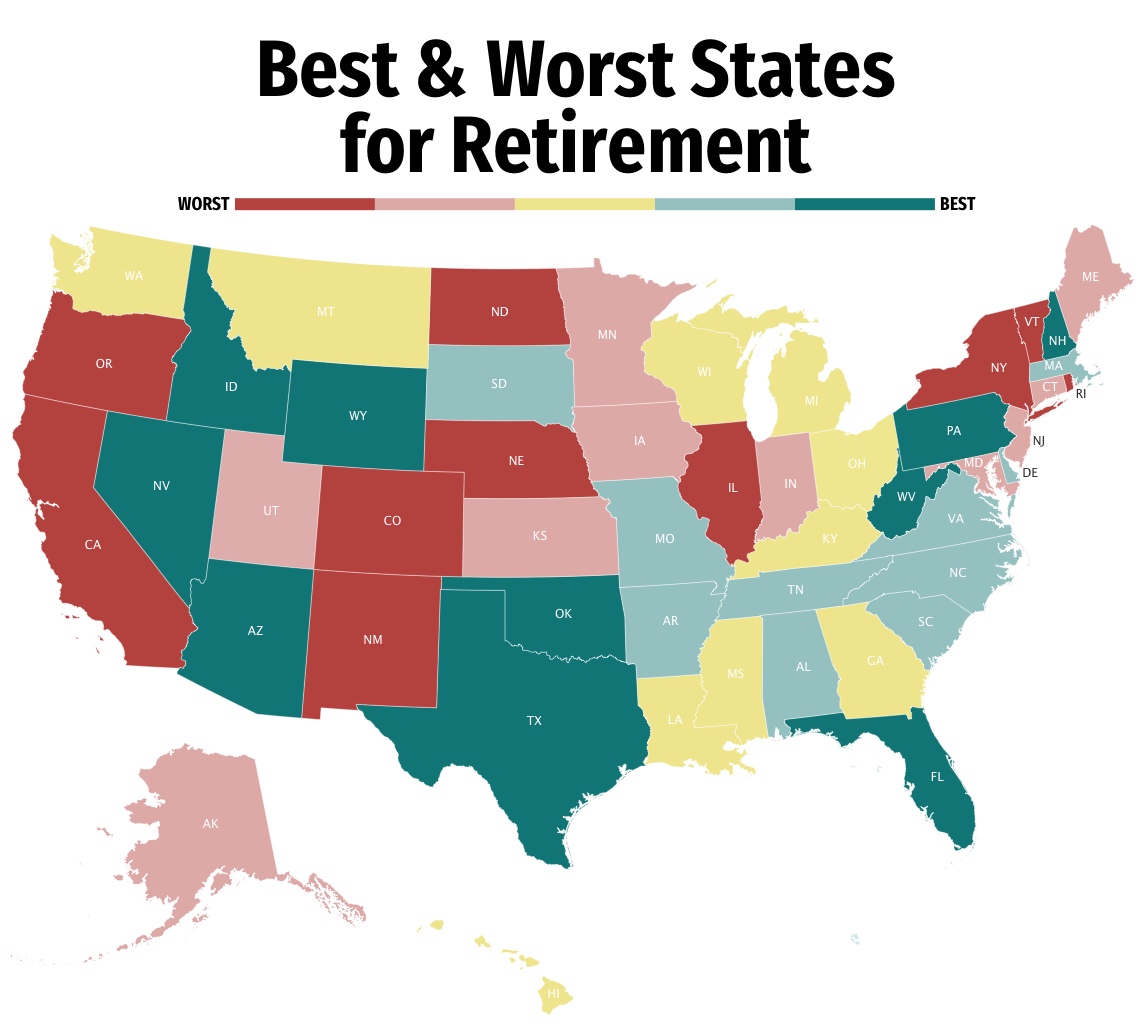Choosing where to retire is an important decision that directly impacts your financial and mental well-being. You’ll want to consider factors such as cost of living, quality of healthcare, taxes, activities and climate. Gathering and analyzing the most critical data from all states to determine where to retire can take many days to complete. We surveyed our readers and crunched the numbers to find the best and worst states for retirement in 2021.

Our analysis will help you find the best states for retirees and the states to avoid. We considered our survey respondents’ comments, then researched that information to confirm validity. We gathered data for taxes and other living expenses that affect retirees. Finally, we took a look at other data for all 50 states, including:
• Affordability: Median Income, Average Home Price, Top State Tax Rate & Cost of Assisted Living
• Quality of Life: Percentage of Population Over 65, Percentage of Population in Poverty and Parkland by Acre
• Healthcare: Number of Hospitals Per 100,000, Number of Hospital Bed Per 100,000, Number of Physicians Per 100,000 and Number of Dentists Per 100,000
• Retirement Living rating
We parsed the data to find the top 10 retirement destinations and 10 states to avoid. You’ll find those states listed below, with the pros and cons of each, gathered from survey results. We recommend consulting with a financial planner if you want to retire to a state that’s less retirement-friendly.
10 Best States for Retirement
1. Florida
Our survey respondents told us Florida is the state that’s best for retirement. Housing is affordable, activities are always available and winters are warm. Retirees in Florida make up 20.9% of the state’s population, so there’s an abundance of senior communities and many activities. The absence of state income tax helps keep the cost of living moderately low. You’ll find many senior-specific products and services in the Sunshine State and endless gorgeous sunsets over the ocean.
The “snowbirds” can cause crowding and disturb Florida’s tropical paradise appeal. Those who prefer not to deal with crowds can find out which counties will experience a decade of population explosion. Some survey respondents mentioned the crime rate, but our research revealed crime is decreasing in Florida.
2. Texas
Texas retirees have access to wide-open space and exciting cities like El Paso and Dallas. The state has a reputation for friendly, welcoming people. There’s no shortage of historic venues, like the Alamo, Victorian mansions and a former sugarcane plantation. Texas is home to over 1.6 million acres of parkland, with plenty of fishing, hunting and recreational areas. The median household income is around $62,000, with no tax on income. Many of our readers said they love the weather, but temperatures can dip into freezing or soar over 100 degrees.
Texas’ average home is priced under $175,000, but property taxes are a burden. Crime statistics vary a great deal by county, but the crime rate is increasing across the state. One offense that’s on the rise and can specifically impact seniors is vehicle theft. Keep your car locked in Texas. Crowding and the lack of sidewalks were areas where our survey respondents would like to see improvement.
3. West Virginia
West Virginia homes and senior care communities are affordable. Over 20% of the population is 65 or older, so retirees easily find peers. The West Virginia University Health System provides quality health care and dental care across the state. The cost of living is very affordable, with low property and sales taxes. You’re within 100 miles of city conveniences no matter where you live in West Virginia.
A downside of living in West Virginia is the lack of activities during the winter months. Retirement income taxes are high for some residents, but West Virginia is phasing out the tax on Social Security income.
4. Nevada
Nevada is a tax-friendly state, making it ideal for many retirees. You’ll pay no regular or retirement income tax, and Nevada property taxes are low. The state sales tax is under 5%, although county taxes can drive that number up beyond 8%. The weather is pleasant most of the year, and you can enjoy the desert and go skiing in one day. You’ll find gambling and a variety of shows in Nevada, as well as hiking, sightseeing and golf across the state.
Our survey respondents felt many Nevada areas lost their small-town appeal with the 14% population increase over the past decade. The average home price is moderately high, at $267,900. Although Nevada offers a dry climate, the late summer heat may be difficult to tolerate. Gambling addiction is a problem, and there are crowded roads and high parking fees in some areas.
5. New Hampshire
New Hampshire offers four distinct seasons, along with beaches, lakes, mountains, cities and countryside for a well-rounded retirement. Many residents enjoy the safety and peace in rural areas and excellent support services. Retirees can easily find activities and join social groups. The average home price is affordable for most people, but you’ll need to plan for the real estate transfer tax. This tax is one of the highest in the country. Long-term care and senior housing costs are the highest in our top 10 retirement states.
New Hampshire imposes sales tax on prepared food, hotels and car rentals. There’s a small tax on telecommunications and alcohol and no tax on retirement income. While the four seasons provide a welcome change, New Hampshire winters can present snow and ice hazards. If you choose to live in a city, you may have to deal with some crowding.
6. Wyoming
Wyoming is an ideal place to retire if you love the great outdoors. The state has over 2.5 million acres of parks and wilderness. Residents enjoy year-round outdoor sports, horseback riding, hiking, fishing and sightseeing. You’ll find peaceful living in Wyoming, with miles of country between cities. The trade-off is the hourslong round trip when you need to visit a city for shopping or health care. Long winters come with high heating costs.
• Emergency medical care sometimes requires helicopter service to get to a hospital.
• Recent Wyoming economic figures show a notable increase in food costs, but transportation costs are down by over 7%.
7. Idaho
Idaho is another state with wide-open spaces with plenty of recreational opportunities. Residential and senior housing options are affordable, but you may have to travel some distance for medical care. Idaho taxes on property and retirement income are low. Some survey respondents complained about population growth, but the population change is 50% of the U.S. average.
• The majority of residents hold conservative or moderate political views.
• The Idaho crime rate continues to fall.
8. Pennsylvania
Nearly 19% of Pennsylvanians are over age 65, so retirees can find friends in their age group. Home prices and the state income tax are low, but care in your later years can quickly add up. The cost of memory care and nursing homes is higher than most other top retirement states. However, there are many senior housing options to choose from. The state has friendly living conditions for veterans.
• Property taxes are moderately high.
• Some roads need work, and the winters aren’t for everyone.
9. Arizona
You won’t run out of activities if you retire to Arizona. The state has beautiful landscapes, from the mountains to the Grand Canyon. Civic events, art fairs, skiing, golf, biking and hiking activities are all at your fingertips. You’ll have no problem finding retirement communities and assisted living facilities in Arizona. Property taxes are reasonable, although there is a tax on retirement income. The winter weather is very comfortable, but the summer months require staying indoors or around the pool.
• Public transportation is lacking in some areas.
• Burglary and theft are on the rise, requiring home security systems.
10. Oklahoma
Housing costs and property taxes are low in Oklahoma. The average sales tax is 9%, but Social Security is not usually taxed. There’s also a $10,000 deduction on other retirement income. Some survey respondents complained that there wasn’t much to do in Oklahoma. Others say there’s no shortage of activities for retirees. If socializing is important to you, do some research on the part of the state you intend to live in.
• The cost of living is stable.
• Assisted living and in-home care costs are affordable.
10 Worst States for Retirement
1. Rhode Island
2. New Mexico
3. Illinois
4. North Dakota
5. Vermont
6. New York
7. Nebraska
8. California
9. Colorado
10. Oregon
Methodology
In our search to identify the best and worst states for retirement, we evaluated 15 data sources that fall into four categories: cost of living, quality of life, healthcare, and RetirementLiving Score.
To evaluate the cost of living we standardized the median household income, average home price, top state tax rate, and the cost of assisted living care. Each of the four data points are worth 5% of the state’s final score.
When considering quality of life, we standardized the percentage of the population over 65, the percentage of the population in poverty, and number of acres of parkland compared to the total landmass of the state. Each of these three data points are worth 6.67% of the state’s final score.
To compare the healthcare environments within each state, we standardized the number of hospitals per 100,000 residents, the number of hospital beds per 100,000 residents, the number of physicians per 100,000 residents, and the number of dentists per 100,000 residents. Each of the four data points are worth 5% of the state’s final score.
Finally, we surveyed our readers and received more than 1,700 responses. We simply asked our readers to rate their state for retirement. The scores and responses from our readers were in line with our statistical analysis, but gave us an anecdotal view into what it is like to actually retire in a particular state.




